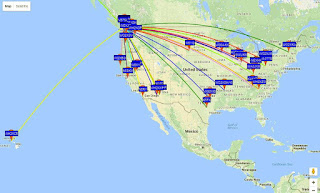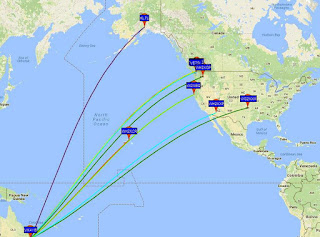 September Prop Awakens
September Prop Awakens

As our sunsets start to come earlier and dawn arrives later and later, the sun's accelerated southerly excursion has brought sudden changes to 630m propagation.
This past weekend's CLE activity saw universally poor propagation as well as weather related QRN from lightning ... but as usual at this time of the year, things can change rapidly. Wednesday's overnight map of my own 630m WSPR activity illustrates why September propagation on LF and MF can often be spectacular and this is with just 65 watts total power output:
 |
| courtesy: http://wsprnet.org/drupal/ |
Among other things, the map indicates the growing interest among U.S. amateurs in the 630m band. Hopefully they won't have to wait too much longer, although I seem to be saying this more often than I would like to. It is of interest to note that even though these were WSPR reports, signal levels at most reporting stations were either into the 'audible CW' levels or at 'JT9 workable' levels ... all stations should be workable once the 630m ham band becomes a reality for all North Americans. Midwinter conditions over the next several years should see an abundance of transcontinental contacts on both CW and on JT9!
The east-west path is the bread and butter direction for interesting possibilities, when it comes to those of us in VE7 land. Normally it only really sets in when geomagnetic conditions are quiet but, as a result of coronal hole streaming, this week's geomagnetic field has been anything but quiet. As John Langridge, KB5NJD / WG2XIQ reported today in his invaluable '630m daily reports':
The geomagnetic field was extremely active, with many reporting periods at storm levels. The Bz is pointing to the South and solar wind velocities are very high, peaking at 700 km/s. This event is significant and I am just glad to see that it is helping and not hurting propagation. When will the bottom drop out? Clearly there is a lot going on here that we do not understand.
With stormy conditions continuing throughout the week, Friday's path to down-under enjoyed some enhancement as well, not unusual when the east-west path is disturbed. VK4YB's 90 watt signal was widely heard by several VE7's (VE7CNF, VA7MM and VE7BDQ) in the predawn hour, as Roger's signal peaked up briefly for several WSPR decodes.
 |
| courtesy: http://wsprnet.org/drupal/ |
As the coronal hole streaming continues, this morning's path to VK seemed even better along with a new antenna at VK4YB favoring the northwest:
12:24 VK4YB 0.475622 -21 VE7BDQ 11844 km
12:12 VK4YB 0.475621 -22 VE7BDQ 11844 km
12:08 VK4YB 0.475622 -17 VE7BDQ 11844 km
11:04 VK4YB 0.475622 -24 VE7BDQ 11844 km
11:02 VK4YB 0.475623 -22 VE7BDQ 11844 km
10:54 VK4YB 0.475623 -22 VE7BDQ 11844 km
12:28 VK4YB 0.475626 -21 VE7SL 11820 km
12:24 VK4YB 0.475625 -23 VE7SL 11820 km
11:54 VK4YB 0.475623 -25 VE7SL 11820 km
11:04 VK4YB 0.475623 -23 VE7SL 11820 km
11:02 VK4YB 0.475625 -26 VE7SL 11820 km
10:54 VK4YB 0.475626 -21 VE7SL 11820 km
11:22 VK4YB 0.475614 -28 VA7MM 11872 km
11:04 VK4YB 0.475614 -28 VA7MM 11872 km
11:02 VK4YB 0.475615 -33 VA7MM 11872 km
10:54 VK4YB 0.475615 -26 VA7MM 11872 km
I should mention that the other VE7 stations are all operating from noisy suburbs near Vancouver ... clearly fine examples of what can be done on 630m under less than ideal operating conditions and by paying close attention to system optimization. Please don't let living in the city stop you from enjoying the mysteries and challenges that our latest ham band has to offer ... as mentioned earlier, there is still much to be learned about using this band at amateur radio power levels and small backyard antennas. How exciting is that!













